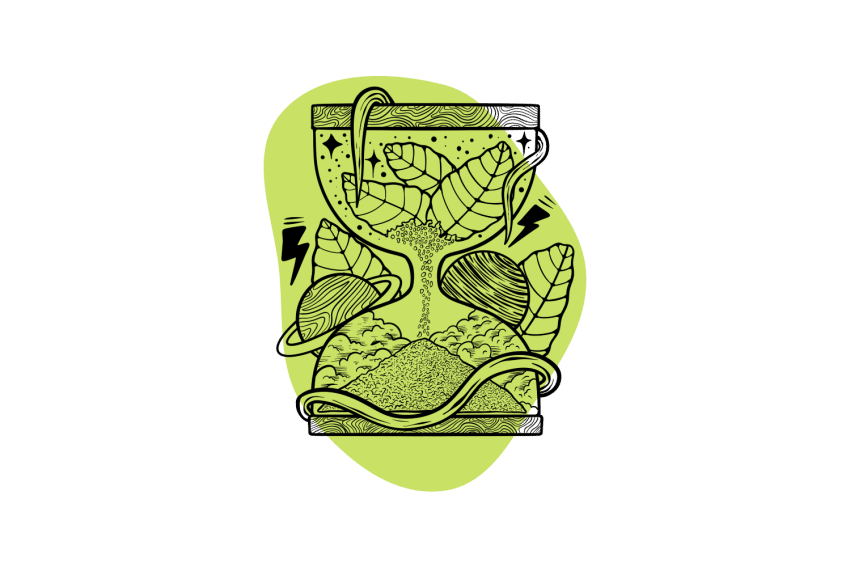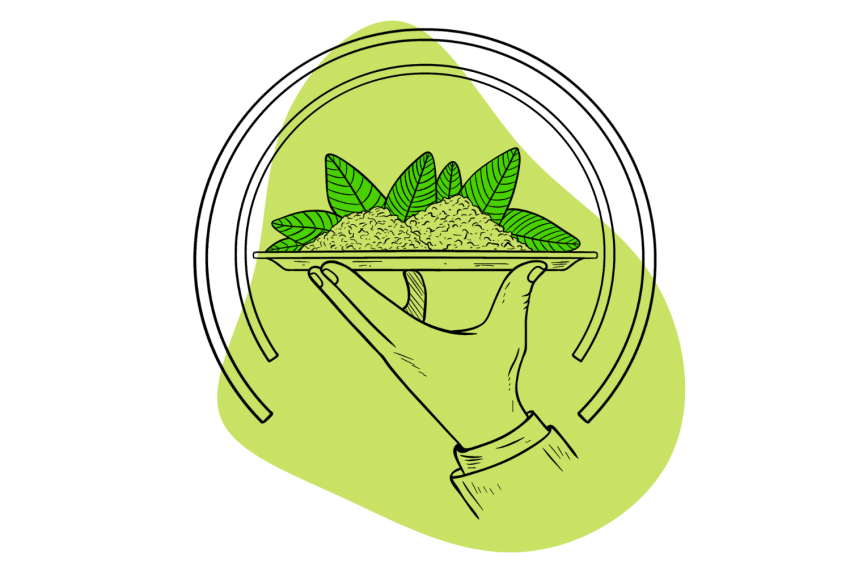All You Need to Know About Kratom Withdrawal, & Then Some
Kratom withdrawal doesn’t tend to last as long or hit as hard as opiate withdrawal — but you’ll still need to be patient.

It’s important to understand that kratom withdrawal is not like opioid withdrawal. In fact, many people often use kratom to break their addiction to opiates.
That said, kratom addiction happens, and users are left wondering what they’re going to face when they try to stop.
Here’s a look at how long kratom withdrawal lasts, how it’s different from opioid withdrawal, and how to get over it as easily as possible.
Related: Kratom 101 (Mitragyna speciosa)
How Long Does Kratom Withdrawal Last?
Kratom withdrawal symptoms are similar to opioid withdrawal but aren’t as severe and don’t last as long. There are reports of people being over the withdrawal in a matter of days [1].
Unfortunately, there’s limited information, so we’re basing this information on user reports and the most current reviews.
Stage 1
This stage starts as kratom’s effects end — usually about 6-8 hours after consumption. It can take a day or more for the alkaloids to leave your body, leaving you feeling continually worse [2]. You’ll be tempted to take more kratom at this point, partly out of habit, but find something else to think about.
Stage 2
Stage two lasts a few days — often up to four — and can leave you feeling lousy. Cravings and symptoms will intensify and peak, but stick with it. Read our tips below on how to ease the discomfort and stay strong.
However, this is as bad as it gets for some people.
Stage 3
You’re almost there! The worst of it is over — it’s all uphill from here. More than likely.
This stage can last up to two weeks, but the symptoms are milder at this point.

What to Expect: Kratom Withdrawal Symptoms
Stopping kratom brings a host of withdrawal symptoms — sometimes. Many people don’t even notice.
Common signs of kratom withdrawal (for the unfortunate) include [3]:
- Anxiety — This happens during withdrawal due to a chemical imbalance and can be more severe if you’re using kratom to help with anxiety.
- Restlessness — Cravings and other discomforts can cause mental and physical agitation and give you the urge to move.
- Depression — This symptom sets it apart from opioids due to kratom’s interaction with dopamine.
- Insomnia — Even if you’re tired all of the time, it’s common to have trouble sleeping. Try not to become sleep-deprived, as that can cause more problems.
- Muscle Pain — Opioid-induced hyperalgesia (OIH) comes from long-term opioid use that causes you to be more sensitive to pain.
- Flu-like Symptoms — Fever, fatigue, sneezing, or a runny nose are common but harmless and disappear after a few days.
- Restless Legs Syndrome (RLS) — This is described as an intense itching or crawling sensation on your legs and an uncontrollable urge to move them.
- Post-Acute Withdrawal Syndrome (PAWS) — Symptoms such as insomnia, depression, fatigue, and irritability last for weeks or months; even though it’s not permanent, it is disruptive.

Making Withdrawal Easier
Most people get through withdrawal with no issues — they carry on with their daily life and don’t feel any differently or think they’re getting sick. Those with prior opioid addictions tend to struggle more, though everyone is different.
The following tips can help with whatever withdrawal throws at you [1], but check out our article on how to quit kratom for more in-depth information.
1. Take OTC Meds & Supplements
Over-the-counter (OTC) pain medications like acetaminophen and ibuprofen can reduce the aches and pains and might even help you sleep better. Anti-diarrhea medicine can ease GI issues.
L-theanine or kava are great options for anxiety, insomnia, and muscle tension symptoms. Caffeine can give you energy when you feel sluggish.
The idea is to find supplements that can boost energy, improve mood, decrease pain, or help you sleep. Mix and match (when it’s safe to do so) to find what works best for your needs.
There are many things that can help manage specific symptoms in the early stages, but some discomfort is a necessary part of reversing tolerance.
2. Take Care of Yourself
Stay hydrated — dehydration will make you feel worse, so keep a supply of water on hand and sip it consistently throughout the day.
You might be more exhausted than usual, and that’s okay. Rest when you need to — take a day or two off work if necessary. However, some people do better by staying busy and would rather not have the time to dwell on their discomfort, and that’s fine, too.
Maybe you’ll be lucky and not notice much of a difference in how you feel.
The point is to give yourself some grace and take it easy.
4. Get Help
If withdrawal feels unmanageable, get help. Don’t feel bad about reaching out for professional help or asking a friend for support.
Tips for Avoiding Addiction & Withdrawal
A little diligence can help you avoid addiction, so you never have to worry about withdrawal. The following rules are easy to follow and work most of the time [7].
1. Use As Little As Possible
It can be easy to make a habit of drinking kratom tea the same way you drink coffee — but don’t. Only use it when necessary, and always use the smallest dose possible.
2. Take Breaks Every Week
Take a break from kratom for a few days every week. Stopping its use one week every month will further ensure you won’t build a tolerance or addiction.
This can be hard if you use kratom for pain, but try to find an alternative for as long as possible.
How Does Kratom Withdrawal Differ from Opioid Withdrawal?
Kratom gets a bad rap since it is an opioid receptor agonist — but it doesn’t deserve it. Use kratom responsibly, and the risks are minimal, unlike prescription opioid medications, which can be dangerous regardless [4].
In general, kratom is much safer — even the addiction and withdrawal are not as severe. Here’s how it differs from opioid withdrawal [5, 6, 7].

1. It’s Harder to Become Addicted to Kratom
First of all, kratom is much harder to become addicted to in the first place. Studies show it usually happens over an extended period (many months) and with heavy use, but even this isn’t consistent — some people never become addicted at all. It’s also more likely for people who have dealt with opioid addiction in the past.
Compare this to opioid addiction, which can occur after a few weeks of using them — and some people become more prone to opioid use disorder after using them just once.
2. Symptoms are Milder
Kratom and opioid withdrawal symptoms are similar, but kratom’s are milder. A current look at the research shows that most people can manage the symptoms on their own. Opioid withdrawal can be dangerous and often requires medical help.
Can You Overdose On Kratom?
Kratom is safer than opioids as well — it’s unlikely to cause an overdose on its own. In fact, one study found the risk of overdose death to be 1000 times greater with opioids than with kratom. You might feel miserable for a while, but it doesn’t suppress the central nervous system like opioids do [10].
It also has a high LD-50 (the amount considered toxic for at least half of a test group). It hasn’t been tested in humans, obviously, but the LD-50 in rats is 200–960 mg/kg for mitragynine and 200–591 mg/kg for total alkaloid extract [11]. It would be “tremendously hard” to take that much kratom if you’re using leaves or powders, but extracts make it much more likely — so be extra cautious with those.
However, kratom can make an overdose more likely if you use it with other substances. It can interact with many drugs, illicit and prescription, so avoid using it unless you’ve talked to your doctor.
Looking Beyond Addiction: Other Risks of Kratom Use
Addiction isn’t the only danger associated with kratom. While it’s mostly safe, it can be dangerous when used irresponsibly. Plus, there are some side effects, though these are mostly mild and go away as the kratom wears off.
1. Drug Interactions
Kratom’s alkaloids are metabolized by the same enzymes that take care of many other drugs [4, 8]. Never use kratom if you’re taking any other substance until you know it’s safe. The biggest danger is mixing it with drugs that impact the central nervous system, like opioids, benzodiazepines, and amphetamines.
2. Side Effects
Kratom also has some side effects that are good to be aware of [9].
The following short-term adverse effects are usually mild and happen when you take too much:
- Headaches
- Dizziness
- The “wobbles”
- Nausea
- Vomiting
- Constipation
- Anxiety
- Fatigue
If you’re careful, you might never experience any of these — simply pay attention to the dosage. If you do start to feel off, try to rest, and it’ll pass.
Long-term effects are lesser known simply because we’re in the beginning stages of kratom research. Some case studies suggest kratom could cause liver, heart, or kidney problems, though this seems to be rare [5].
3. Impure Products
Because of the lack of regulations, it’s easy for bad kratom to make its way into the market. Best-case scenario, the kratom isn’t very potent; worst-case scenario, it’s contaminated and makes you very sick, or it has adulterants added to it, making it potentially dangerous.
Luckily, there are plenty of reputable vendors that sell great kratom. Just look for ones that have good reviews and have their kratom tested by third-party labs. Hint: You’ll have more luck looking online than in a local shop.

FAQ: Kratom
Here are some common questions we get asked about kratom — answered.
1. Is kratom legal?
Mostly, yes, but some places have banned or regulated it. In the US, kratom is unregulated federally, and most states haven’t addressed the issue. Basically, it’s either in every gas station, or it’s a Schedule 1 drug and can get you prison time and a criminal record. Do yourself a favor and check local laws to be sure where your area stands.
2. Where can I buy kratom?
Because kratom is unregulated in most places, the consumer has to play the role of Quality Control. Some places have adopted laws that oversee manufacturing and selling, but most haven’t.
Fortunately, many online vendors take kratom — and their customers’ safety — seriously and go to great lengths to make sure their products are high-quality. The number one thing to look for is third-party testing since these show what exactly is in there, from contaminants to alkaloid content.
3. How much kratom do I take?
The amount of kratom you need depends on many personal factors and what you’re using it for. If you want energy, focus, or a mood boost, take 2-5 grams. Take a larger dose, about 4-8 grams, for relaxation, pain, sleep, or anxiety.
Start with less and work your way up, but only if you need it.
References
- Swogger, M. T., Smith, K. E., Garcia-Romeu, A., Grundmann, O., Veltri, C. A., Henningfield, J. E., & Busch, L. Y. (2022). Understanding kratom use: a guide for healthcare providers. Frontiers in pharmacology, 13, 801855.
- Trakulsrichai, S., Sathirakul, K., Auparakkitanon, S., Krongvorakul, J., Sueajai, J., Noumjad, N., … & Wananukul, W. (2015). Pharmacokinetics of mitragynine in man. Drug design, development and therapy, 2421-2429.
- Abdullah, B., & Leong, M. F. I. (2020). Kratom dependence and treatment options: a comprehensive review of the literature. Current drug targets, 21(15), 1566-1579.
- Johnson, L. E., Balyan, L., Magdalany, A., Saeed, F., Salinas, R., Wallace, S., … & Grundmann, O. (2020). Focus: Plant-based Medicine and Pharmacology: The Potential for Kratom as an Antidepressant and Antipsychotic. The Yale journal of biology and medicine, 93(2), 283.
- Prevete, E., Kuypers, K. P. C., Theunissen, E. L., Corazza, O., Bersani, G., & Ramaekers, J. G. (2022). A systematic review of (pre) clinical studies on the therapeutic potential and safety profile of kratom in humans. Human Psychopharmacology: Clinical and Experimental, 37(1), e2805.
- Wilson, L. L., Chakraborty, S., Eans, S. O., Cirino, T. J., Stacy, H. M., Simons, C. A., … & McLaughlin, J. P. (2021). Kratom alkaloids, natural and semi-synthetic, show less physical dependence and ameliorate opioid withdrawal. Cellular and molecular neurobiology, 41, 1131-1143.
- Henningfield, J. E., Chawarski, M. C., Garcia-Romeu, A., Grundmann, O., Harun, N., Hassan, Z., … & Huestis, M. A. (2023). Kratom withdrawal: Discussions and conclusions of a scientific expert forum. Drug and Alcohol Dependence Reports, 7.
- Hanapi, N. A., Chear, N. J. Y., Azizi, J., & Yusof, S. R. (2021). Kratom alkaloids: Interactions with enzymes, receptors, and cellular barriers. Frontiers in Pharmacology, 12, 751656.
- Prevete, E., Kuypers, K. P. C., Theunissen, E. L., Esposito, G., Ramaekers, J. G., Pasquini, M., & Corazza, O. (2023). Clinical Implications of Kratom (Mitragyna speciosa) Use: A Literature Review. Current Addiction Reports, 1-18.
- Henningfield, J. E., Grundmann, O., Babin, J. K., Fant, R. V., Wang, D. W., & Cone, E. J. (2019). Risk of death associated with kratom use compared to opioids. Preventive medicine, 128, 105851.
- Stanciu, C. N., Gnanasegaram, S. A., Rader III, G. L., Sharma, A., & McCurdy, C. R. (2023). What Is the Kratom Overdose Risk? A Systematic Literature Review. Current Addiction Reports, 10(1), 9-28.








